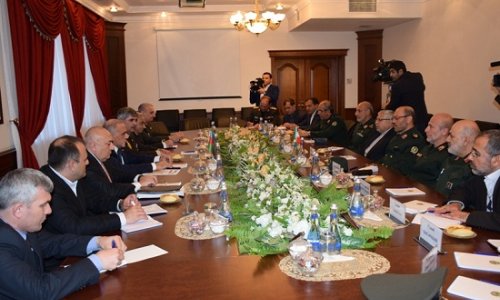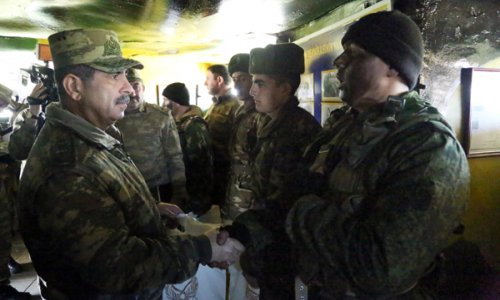Russia’s southern periphery is closer to open war than at any time since the 1990s.
Hostilities between Azerbaijan and Armenia are mounting 21 years after a cease-fire froze a conflict that flared in the dying days of the Soviet Union. During the relative calm, companies including BP Plc poured billions of dollars into producing oil and gas in Azerbaijan and building pipelines to link the country with Turkey, Italy and the rest of Europe.
The upswing in violence now threatens to put some of those investments at risk and destabilize a region that separates Russia from Turkey and Iran. A May 3 election looming in Nagorno-Karabakh, the region Armenians captured more than two decades ago, may trigger a wider confrontation, the Royal Bank of Scotland Group Plc said.
The vote "could further escalate the tensions, increasing the risks of a wider confrontation" over the region, Anna Tokar, an analyst at RBS in London, said in an e-mailed note on April 16. That risks "putting the oil and gas pipelines in the South Caucasus in danger.”
At the center of the conflict, which has simmered with shootouts and other incidents ever since the truce, is Nagorno-Karabakh, an ethnic Armenian-majority region that remains internationally recognized as part of Azerbaijan.
The first four months of the year have been the deadliest, according to the Caspian Defense Studies Institute in the Azeri capital, Baku. There have been 31 confirmed deaths so far this year in clashes on the front line, according to Jasur Sumarinli, head of the research group.
‘Hybrid War’
With the world focused on the conflict in Ukraine, the escalation is rattling a region crisscrossed by pipelines after BP and its partners invested more than $50 billion in Azeri energy projects. Azeri incursions into the Armenian-controlled areas surrounding Nagorno-Karabakh are raising pressure along the disengagement line separating the adversaries, torn apart by religion and international alliances.
Armenia’s Defense Ministry is accusing its foe of waging a "hybrid war” of "micro-activities” from information attacks to armed forays. President Serzh Sargsyan, told France 24 on March 21 that all-out war may resume "at any time.”
Azeri Defense Minister Zakir Hasanov told his soldiers last month to "take every opportunity, day and night” to kill Armenians controlling what’s internationally recognized as Azeri territory.
‘Fully Confident’
"I am fully confident that we’ll get what we want,” Azeri President Ilham Aliyev said in a televised speech in March. "We’ll restore our territorial integrity.”
Another five Armenian soldiers were reported killed by Azerbaijan on April 21, which the Armenian side later denied. In turn, the armed forces of Nagorno-Karabakh said the same day that at least one Azeri soldier died during fighting northeast of the region. The Azeri Defense Ministry said its troops sustained no losses.
"There is nowhere to escalate to -- it will only take one miscalculation,” said Lawrence Sheets, a political analyst on the Caucasus based in neighboring Georgia. "It was small arms for 20 years. Then it became about using artillery, drones, aircraft.”
A wider outbreak would threaten to shake the energy infrastructure around Azerbaijan, which provides the only westward route for central Asian crude that bypasses Russia.
The BP-led Baku-Tbilisi-Ceyhan oil pipeline runs through territory less than 100 kilometers from the cease-fire line.
The Caspian Sea nation signed $45 billion of contracts with European buyers in 2013 to supply gas via 4,000 kilometers (2,500 miles) of pipelines that stretch from Baku to southern Italy through Georgia, Turkey, Greece and Albania.
Weapons Program
Azerbaijan, the former Soviet Union’s third-largest crude producer, has used its oil wealth to beef up its military and forge alliances with the U.S. and Israel. Its multi-billion-dollar rearmament program made it Europe’s second-biggest weapons importer in the past five years at 13 percent of total purchases, the Stockholm International Peace Research Institute said in a report this month.
The government in Baku increased military spending 27 percent this year to 3.8 billion manat ($3.6 billion), outlays exceeding Armenia’s total annual expenditures. Armenia, though, is a member of a Russian-led mutual defense group and hosts a Russian military base.
As fighting raged in 1993, Armenia took control of Nagorno-Karabakh and seven surrounding Azeri districts, justifying the move by the need to create a buffer zone. About 30,000 people were killed and 1.2 million displaced during the war. Four United Nations Security Council resolutions were passed demanding withdrawal.
Trench Warfare
Tensions along the heavily militarized cease-fire line, where soldiers face each other in World War I-style trenches, last escalated in August. At least 19 troops were confirmed killed in several days of clashes.
Since then, Azerbaijan has started using 120-millimeter mortar fire for the first time in 20 years, Arman Kirakossian, Armenia’s envoy to the Organization for Security and Cooperation in Europe said March 26. Azerbaijan said its positions came under fire from 60-millimeter and 82-millimeter ammunition.
"This is happening now because Russia is preoccupied with Ukraine,” said Elxan Shahinoglu, head of the Atlas policy research group in Baku. "Azerbaijan has been in intense talks with Russia to gauge the Kremlin’s reaction.”
(Bloomberg)
www.ann.az
Follow us !











